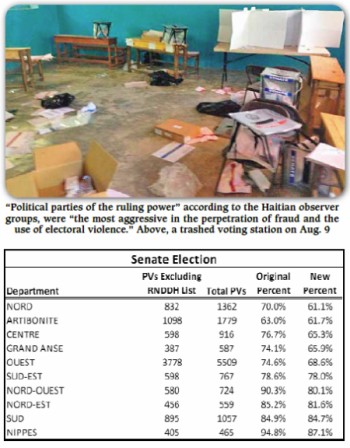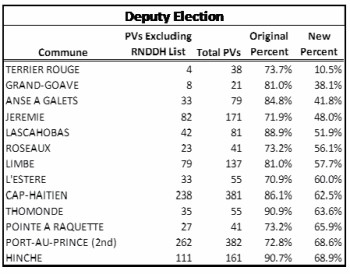|

A
local Haitian observation group has released a
detailed
report from
election day, calling into question the legitimacy of
the vote in many areas throughout Haiti. The group, made
up of RNDDH, CNO and CONHANE, had observers present in
48% of voting centers throughout the country. The
observers state that in more than 60% of polling centers
where they were present there was massive fraud or
attempted fraud, serious irregularities, intimidation
and violent or aggressive acts.
The report continues: “The executive authorities,
officials of the electoral body as well as many
political parties and candidates each share a part of
the blame for what can be considered an electoral
fiasco.
“In effect, after having spent four years in
power without holding elections that the people were
calling for, after having spent four years
procrastinating and trying to place the blame on other
actors involved in the elections, the executive
authorities produced these electoral contests where the
political parties of the ruling power, namely PHTK and
Réseau National Bouclier Haïtien, have been identified
as being, on the day of the election, the most
aggressive in the perpetration of fraud and the use of
electoral violence as a means to success.”
The Provisional Electoral Council (CEP) has
announced that elections will be re-run in 25 areas
where the number of tally sheets counted
was below 70%. The
Senate election in the Artibonite will also be re-run in
October. The local observers, however have questioned
the transparency of this decision.
“The CEP has not provided any information about
the handling, at the level of the Tabulation Center, of
the numerous irregularities related to ballot-box
stuffing and vote fraud reported during the election of
Aug. 9 2015,” they wrote. “Moreover, the decision of the
CEP to validate results from a Voting Center based on
the relatively low threshold of 70% of tally sheets
risks causing serious prejudice to candidates who were
the target of violence by their opponents.”
Although the CEP never produced a full list of
voting centers that were closed or where significant
problems ensued, the local observer report lists 104
voting centers where “massive fraud” and violence took
place and where the voting was stopped, at least
temporarily. Although Haiti’s electoral law specifically
states that the suspension of the vote is not, in and of
itself, grounds to annul an election, the closures,
coupled with reports of fraud and violence certainly
raises the question of whether results from these voting
centers should be counted at all.
An analysis of the 104 voting centers where
massive fraud and violence took place showed that in
many cases the CEP never received any tally sheets from
the centers. However, many voting centers that are
listed by RNDDH produced tally sheets which were
eventually accepted and counted by the CEP.
If those additional tally sheets were excluded
from the final results, many different races, at both
the deputy and senate level would fall below the CEP’s
70% threshold.
To demonstrate how sensitive the CEP’s threshold is to
small changes in the number of tally sheets accepted and
counted, the breakdown below shows the impact of
excluding tally sheets from voting centers listed in the
local observer report.
As can be seen, by removing tally sheets from voting
centers listed by the RNDDH-led local observer group,
four additional departments would need to re-run Senate
elections: the Nord, Centre, Grand Anse and Ouest.
Half of PHTK’s eight Senate candidates advancing
to the second round come from these departments and all
four of Bouclier’s do as well. Verité would lose three
of its seven Senate candidates. Both Bouclier and PHTK
were
warned by the CEP
for their involvement in electoral violence in three of
the four departments where Senate elections would no
longer stand. Verité was singled out for its role in
electoral violence in the Nord and Ouest departments,
both areas where the party advanced Senate candidates.
The exclusion of additional tally sheets by the
CEP would also impact the results of a number of races
for Deputy, as can be seen below.

In addition to the 25 areas where the CEP has
already announced elections will be re-run, the removal
of tally sheets from the RNDDH list of voting centers
puts 13 additional areas under the CEP’s 70% threshold.
In Port-au-Prince’s second district, the only
polling center which appeared on the local observer
report list and had tally sheets counted by the CEP was
the Canapé-Vert Market. According to the results
released by the CEP, 16 of the 32 tally sheets from the
market were never received, but the other 16 were
counted. Simply by removing those additional 16 sheets,
the district falls below the 70% threshold.
It is important to keep in mind as well that the
local observers state that their list is only partial
and based on their own observations. It’s likely that
many more voting centers throughout the country
experienced similar problems and tally sheets were still
counted.
Certainly it may be the case that not all the voting
centers listed experienced irregularities that require
all the votes to be discarded, however the analysis
above clearly shows the
arbitrary nature of the CEP’s
low threshold and the need for further transparency
from the organization in terms of how it is determining
which votes count and which are discarded.
|